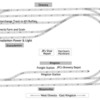DESIGN VS TRACK PLANNING/ARRANGING
I’m writing this blurb to share some “food for thought” with you, my fellow model railroaders, involving developing your future layouts in a manner that will give you a much greater level of satisfaction and enjoyment. I’m hoping to save you a lot of time, grief, effort and wasted money—that was my route—through the school of hard knocks.
I entered into this the greatest of hobbies in the early 1970s. For more than 45 years and counting, the overwhelming vast majority of model railroaders put their respective layouts together via track arranging (track planning). There is virtually no thought given to even the most basic design concepts. The track is simply placed where it fits best without regard to anything else.
Everyone’s first layout or two is a circle or loop of track; which eventually evolves into a tangled web of tracks typically referred to as a “spaghetti bowl.” The positive is the experience gained in laying and powering track. However, these layouts are almost always short-lived because the set-up is such an average person loses interest quickly.
Over the course of history, model railroaders have stated that the reason for their numerous track arrangements is for seeking a more interesting layout; yet these same people keep arranging track to fill space, via trial and error, with NO thought to a design process.
In regard to layout building, IT IS NOT ALL ABOUT JUST ARRANGING TRACK PIECES. That is the tip of the proverbial iceberg and unfortunately far too many people think it’s the end-all. It’s not. To this day when someone requests help planning a layout they are overwhelmed with track arrangements.
I am puzzled by the submitted arrangements because the requester gave no specifics. How do you come up with an arrangement without any information?
The first thing you need to know is exactly what it is you want to do. That absolutely will impact the track arrangement.
If you don’t know where you are going, how can you get there?
Some examples: a track arrangement for the Rockies would look different than the plains. A seaside arrangement would look different that the desert. A logging line would look different than a yard.
To maximize your satisfaction and enjoyment, I would respectfully suggest you consider “patterning” your design on reality. That would help any builder. I’m not suggesting duplicating a real railroad. I’m suggesting design your plan to simulate the actions of real life railroads, including their purpose and operations. This will provide you with fun!
You do not have to pick a specific railroad. You may pattern your fictitious free-lance railroad in a similar fashion to reality.
Please think about and focus on the three critical and essential elements in the formal Model Railroad Design Process:
Plausibility (believable), Purpose and Participation. Truly ALL great model railroads possess these features.
With respect to the Design Process for your future layout, ask yourself: Is your railroad believable? What is its name? Exactly where is it? What is its purpose? What does it do for a living? Last and certainly not least, how will you, and others, become actively engaged in the operation of your well thought out design?
I firmly believe that novices; inexperienced newcomers and even more seasoned model railroaders have grown so accustomed and conditioned, over such a long period of time, that they instinctually just arrange tracks in circle after circle and loop after loop with no rhyme, reason or purpose, or design process because that’s about 99.9% of what we have all seen. After all, we got our new sets like that didn’t we?
Your layout needs to be carefully designed, planned and well thought out prior to laying track. If you are anxious to get up and running, put down a loop of temporary track and enjoy while you plan your actual design.
Please be aware that there are alternatives that are much more engaging and fun for layout operators versus looping.
I strongly encourage everyone, as a fellow model railroad for many years now, to seek out and research information involving how real railroads are laid out, their purposes, their operations, and if you find something intriguing that you may be interested in modeling, research, research, research, analyze, plan and prepare, before you lay the first strip of track. This will maximize your enjoyment and give you a more satisfying design.
Know who your railroad is, where your railroad is, what your railroad does for a living, and how its operators will be an active and involved part of its operations.
I implore and challenge you to “think outside the box.” Don’t settle for another “plywood pacific” or “spaghetti bowl” track arrangement via trial and error. The examples of these styles of layouts are endless. Track planning (NOT DESIGN) books are filled with such arrangements rein enforcing the preconceived notion that all layouts have to be circles of track.
Learn about the model railroad design process, not just arranging track.
Resolve to do something great! Resolve to do something different! I love this hobby as do countless others. I hope that I have given you many things to consider that will help you plan your next design.
I shared this with you today and I really wished someone would have shared this with me about 45 years ago. It would have helped me immensely as a novice.
Don’t forget: Plausibility, Purpose and Participation for your DESIGN.
I hope to see your future great design in a magazine or on video. Good luck and best wishes!
John Robert Coy…………………………………………John
Original Post
Replies sorted oldest to newest








